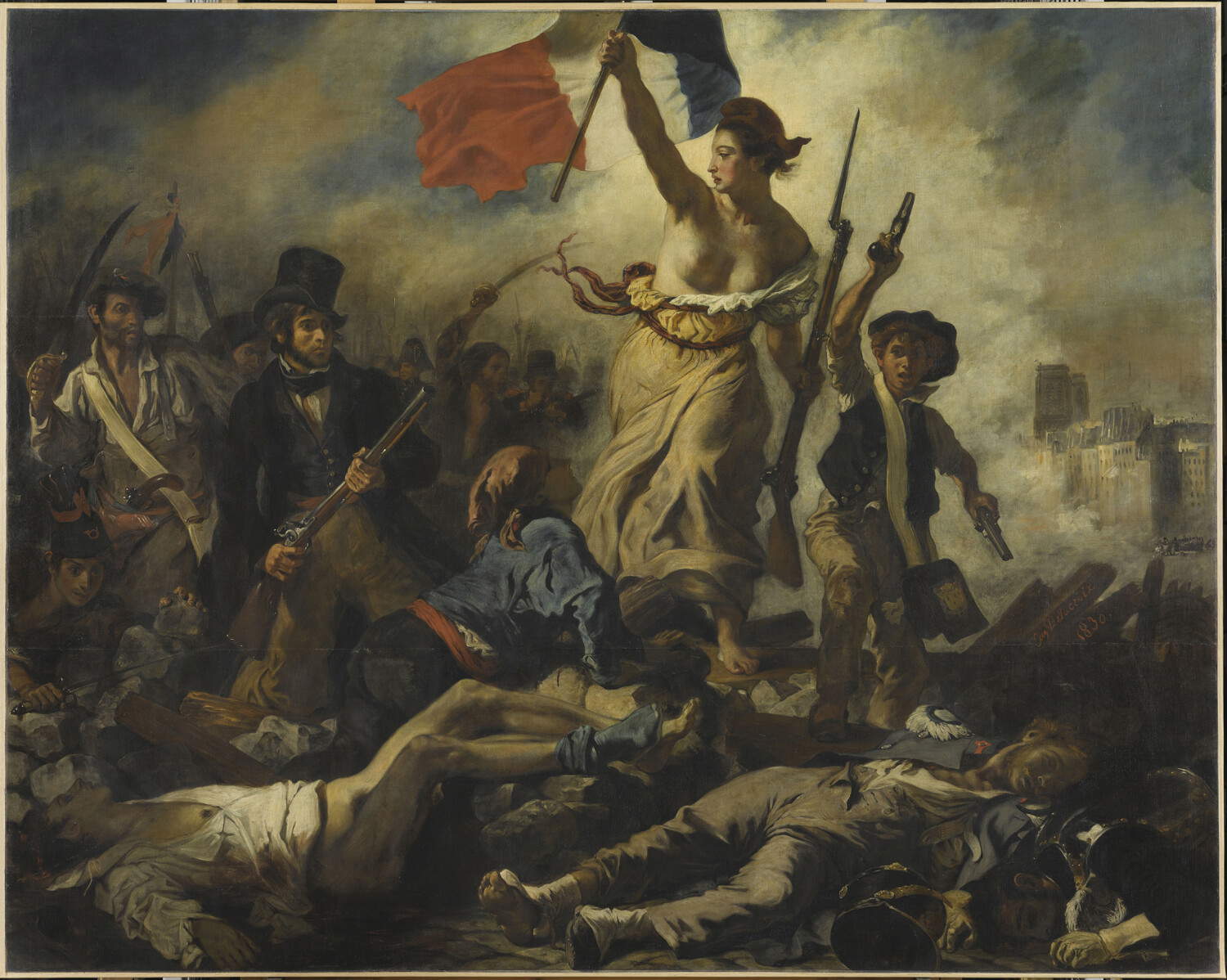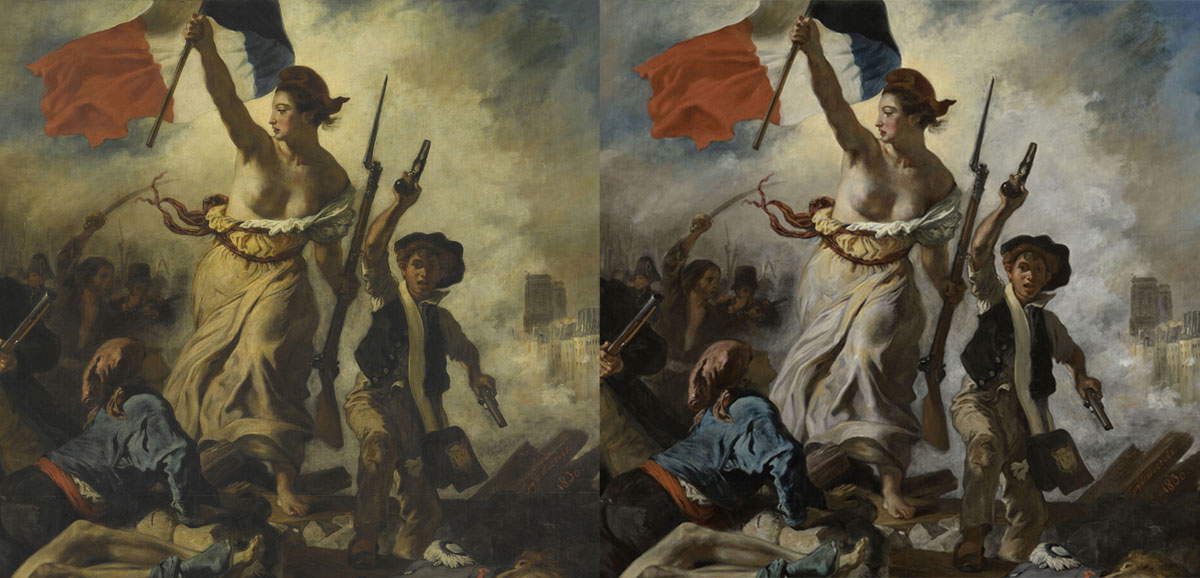After six months of restoration, one of the iconic paintings in the history of French art, Eugène Delacroix ’s (Saint-Maurice, 1798 - Paris, 1863) Liberty Leading the People regains its original colors. Delacroix’s work, perhaps the Louvre ’s most famous after the Mona Lisa, underwent an intervention that took place from October 2023 to April 2024, carried out by Bénédicte Trémolières and Laurence Mugniot, which resulted in the reduction of the layers of oxidized varnish that were suffocating Delacroix’s particularly carefully crafted and subtle palette. And as of today, the work is once again on view in the Louvre’s Mollien Room. “Restoring the heritage we preserve to pass it on to as many people as possible is one of our fundamental missions,” said Laurence des Cars, director of the Louvre. "Thanks to the patient work done by Bénédicte Trémolières and Laurence Mugniot, The Liberty Leading the People has today regained the brilliance, freshness and wonderful harmony of color typical of Delacroix. I am delighted that our visitors can discover or rediscover this immense masterpiece of 19th century painting, a universal icon, symbol of our country and ambassador of its culture and history.“ ”Since its creation nearly two centuries ago," echoed Sébastien Allard, director of the museum’s Department of Painting, "the expressive force of Delacroix’s Freedom Leading the People has never faded, becoming a symbol of many of the world’s liberation struggles. It is one of those rare works that always ’recharges’ depending on the political, social, and cultural context in which it is viewed. The restoration we have carried out has fully restored this momentum."

Eugène Delacroix makes the most of all the properties of color: he relies in a particularly original way on the juxtaposition of colors to shape his volumes, animate his shadows, and then plays with the states of matter (granular, creamy , liquid) to suggest textures and create transparencies. But it is precisely these elements that are annihilated by the darkening andyellowing of the paints. The thinning of these paint layers has first of all restored tone to the work: contrasts are vigorous, the general coolness of tones returns, the three-dimensional illusion is restored. The characters are again distinguished from each other according to the planes assigned to them by the artist. For example, we notice that the boy armed with a gun (often nicknamed “Gavroche,” although this Hugo character is much later) runs in front of Liberty and not beside her. We thus rediscover the richness of the composition: far from being limited to the central trio (Liberty, her flag and her young companion), the painting is rich in detail. Delacroix neglected nothing: no one, for example, had paid attention, before the restoration, to the worn leather shoe, abandoned in a corner, lower left. It was neither hidden nor covered by repainting: the screen of paint had simply confused it optically with the stones of the pavement. The same is true of the buildings visible on the far right: each facade is different from the one next to it, gunfire comes from the windows, firefights with troops materialize with tiny pink streaks in the confusion of smoke.
The main surprise was Liberty’s tunic, which was thought to be uniformly yellow. During an initial test made on the bottom of this tunic, restorers discovered to their amazement that it was a light gray color. Extending the cleaning, Trémolières and Mugniot highlighted the fact that Delacroix had actually painted the entire tunic in gray, first adding a bright yellow in different densities, very opaque at the level of the bust, then increasingly patchy going down the legs. This deliberately faded look was no longer understood during the 20th century; even the last restoration, in 1949, sought to even out the color of the dress, maintaining a thick layer of paint over the entire surface, and adding orange highlights in the folds and outlines. Once these repaintings were removed, the restorers realized that this yellow hue was made to enhance the bust of Liberty. Her chest is framed by the pure yellow of the bodice, at the bottom, and the golden halo set just behind her head, now clearly distinguished from the white smoke present elsewhere. It is the hottest spot in the entire painting, complementary to the other two ubiquitous primary colors, blue and red.
To fit the subject, Delacroix deliberately excluded green, orange and purple from his palette. He constructed his composition by exploiting the full range of colored grays, from the purest white (the reflection of the armor in the lower right corner) to the deepest black (the young man’s vest). On this seemingly austere but nuanced texture, the painter makes the three national colors blue-white-red sing; finally, he remedies the excessive coldness of the result with this golden yellow that also has the virtue of evoking the allegorical, almost divine character of Liberty.
Indeed, blue, white, and red make their triumphant return, on July 28, 1830 (it should be remembered that the full title given by Delacroix to his work is July 28, 1830. Liberty Leading the People), after having been banned under Louis XVIII and Charles X. This constant interaction between the demands of the subject and those of color is now legible again.
The first documented restoration was in the summer of 1949: damaged by the relocations imposed by World War II, the work was re-tinted while the paint layer was lightened and retouched by restorer Michel Zezzos. With the exception of a frame replacement in 1999 during an exceptional loan to Japan, the work has since undergone only minor maintenance: regular repainting and minor cosmetic touch-ups. The thickness and opacity of these many accumulated restoration materials eventually produced a dull, yellow screen that until now obscured many hues and prevented saturation of dark colors. The thinning of the paint layers performed during the current restoration required a great deal of patience and caution. Indeed, the lower third of the painting is painted in a narrow range of black, gray and brown tones, which are more difficult to treat than light tones. Invasive repainting by Michel Zezzos, which highlighted the folds of Liberty’s tunic or covered part of the sky, was therefore removed. A very thin layer of old varnish remained, as well as some retouching applied earlier to hide areas of cracking due to lack of drying. The restoration also highlighted the fact that the original painting did not suffer any loss or tears.
Of all Delacroix’s painted work, Liberty Leading the People is certainly the most famous painting, and yet it is an atypical work. First, it is the only time the artist painted Paris and dedicated a large canvas to the working classes of his country and time. Freedom is also a summary work, summarizing and closing an era of his career, that of his youth. In 1830 Delacroix was 32 years old, he was well known but found himself as if at a dead end. From the age of 24, he had built a solid reputation as a history painter through a series of successes at the Salons, but the bitter failure of The Death of Sardanapalo in 1828 ended his rise. The revolution of July 27, 28, and 29, 1830, provoked by Charles X’s new ordinances designed to suspend freedom of the press, dissolve the Chamber of Deputies, and curtail the right to vote, offered him an unhoped-for opportunity to get back into the game. He was a direct witness to this popular and spontaneous insurrection of Parisians, motivated by a desire to defend the nation’s sovereignty and individual liberties. The success of the movement reawakened the patriotic pride of the French, and particularly resonated in the painter’s heart: the return of the tricolor flag, after fifteen years of censorship, reactivated the memory of his father, minister and ambassador to the republic, as well as his brother officers in the Napoleonic army. Eugène Delacroix therefore set to work in September. He wrote to his brother, “I have undertaken a modern subject, A Barricade ... and if I have not won for the fatherland I will at least paint for her.”
Delacroix returned to a very harsh, veristic painting, reflecting the fatigue of bodies and the sacrifice of lives, without masking the atrocities of a civil war, the horrific spectacle of corpses abandoned for several days in the streets. But in the meantime, he had acquired a maturity that pushed him in search of synthesis and asceticism. Instead of a juxtaposition of anecdotes, of “things seen,” which have the disadvantage of producing a heterogeneous and centrifugal whole, he sought a unifying force for its composition. In this he was helped by the success of his recent allegory of Greece on the ruins of Missolonghi (1826); he also thought back to Géricault’s Raft of the Medusa, on view in the Louvre since 1824. The solution came to him intuitively: the core of his painting would be a pyramid, with the barricade as its base, the value of Liberty as its center of gravity, and the tricolor flag as its crowning glory. This composition signifies the hybridization of traditional pictorial categories: Liberty Leading the People is thus both a historical painting and an allegory, embellished with genre scenes, portraits, still lifes, and an urban landscape. The result is masterful in its balance and mastery, while keeping alive the passion, ease and enthusiasm of youth. The work was easy: the work was finished in December 1830, in just four months.
 |
| Louvre, restored Delacroix's Liberty Leading the People: now we see the original colors |
Warning: the translation into English of the original Italian article was created using automatic tools. We undertake to review all articles, but we do not guarantee the total absence of inaccuracies in the translation due to the program. You can find the original by clicking on the ITA button. If you find any mistake,please contact us.